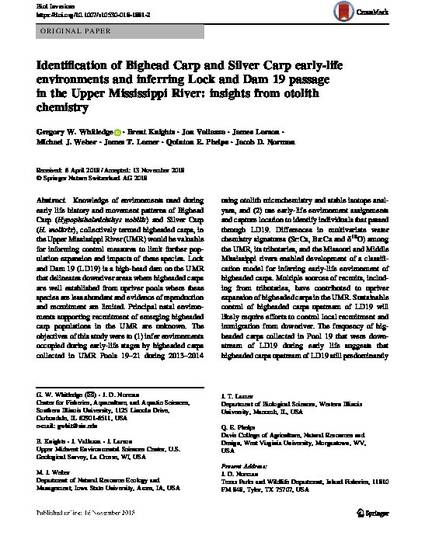
Knowledge of environments used during early life history and movement patterns of Bighead Carp (Hypophthalmichthys nobilis) and Silver Carp (H. molitrix), collectively termed bigheaded carps, in the Upper Mississippi River (UMR) would be valuable for informing control measures to limit further population expansion and impacts of these species. Lock and Dam 19 (LD19) is a high-head dam on the UMR that delineates downriver areas where bigheaded carps are well established from upriver pools where these species are less abundant and evidence of reproduction and recruitment are limited. Principal natal environments supporting recruitment of emerging bigheaded carp populations in the UMR are unknown. The objectives of this study were to (1) infer environments occupied during early-life stages by bigheaded carps collected in UMR Pools 19–21 during 2013–2014 using otolith microchemistry and stable isotope analyses, and (2) use early-life environment assignments and capture location to identify individuals that passed through LD19. Differences in multivariate water chemistry signatures (Sr:Ca, Ba:Ca and δ18O) among the UMR, its tributaries, and the Missouri and Middle Mississippi rivers enabled development of a classification model for inferring early-life environment of bigheaded carps. Multiple sources of recruits, including from tributaries, have contributed to upriver expansion of bigheaded carps in the UMR. Sustainable control of bigheaded carps upstream of LD19 will likely require efforts to control local recruitment and immigration from downriver. The frequency of bigheaded carps collected in Pool 19 that were downstream of LD19 during early life suggests that bigheaded carps upstream of LD19 still predominantly consisted of immigrants from downriver during 2013–2014. Otolith chemistry provides an approach for assessing the extent to which changes in abundance of bigheaded carps upstream of LD19 are associated with local recruitment or immigration from downriver.
Available at: http://works.bepress.com/michael_weber/25/

This article is published as Whitledge, Gregory W., Brent Knights, Jon Vallazza, James Larson, Michael J. Weber, James T. Lamer, Quinton E. Phelps, and Jacob D. Norman. "Identification of Bighead Carp and Silver Carp early-life environments and inferring Lock and Dam 19 passage in the Upper Mississippi River: insights from otolith chemistry." Biological Invasions (2018). doi: 10.1007/s10530-018-1881-2.